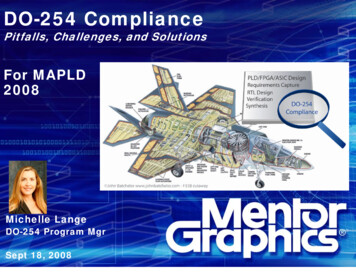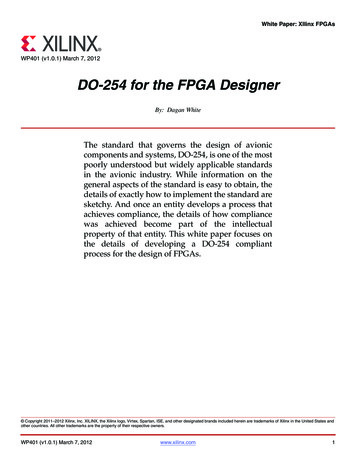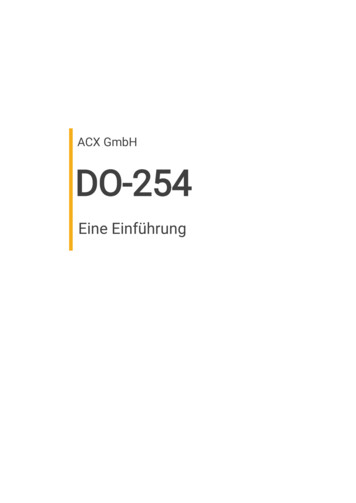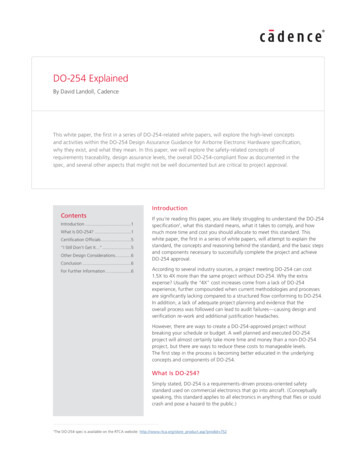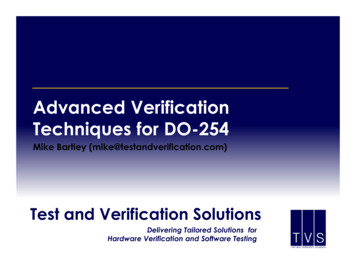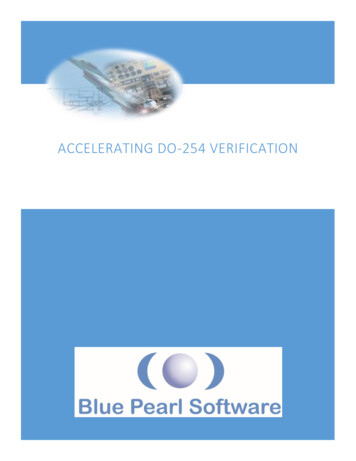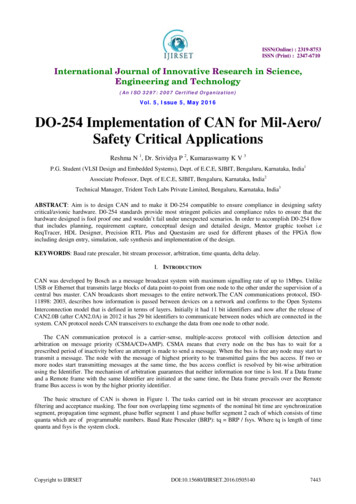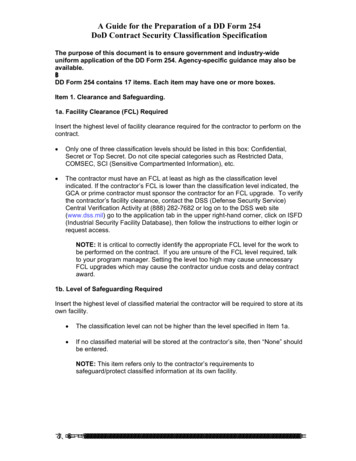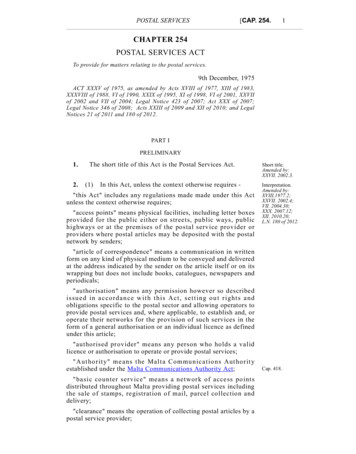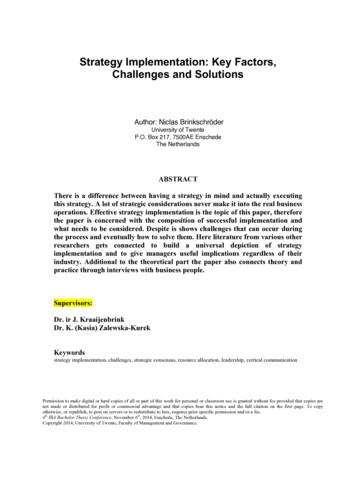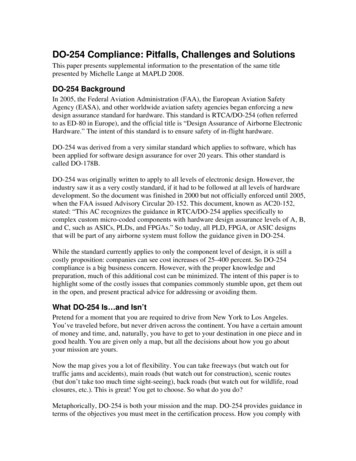
Transcription
DO-254 Compliance: Pitfalls, Challenges and SolutionsThis paper presents supplemental information to the presentation of the same titlepresented by Michelle Lange at MAPLD 2008.DO-254 BackgroundIn 2005, the Federal Aviation Administration (FAA), the European Aviation SafetyAgency (EASA), and other worldwide aviation safety agencies began enforcing a newdesign assurance standard for hardware. This standard is RTCA/DO-254 (often referredto as ED-80 in Europe), and the official title is “Design Assurance of Airborne ElectronicHardware.” The intent of this standard is to ensure safety of in-flight hardware.DO-254 was derived from a very similar standard which applies to software, which hasbeen applied for software design assurance for over 20 years. This other standard iscalled DO-178B.DO-254 was originally written to apply to all levels of electronic design. However, theindustry saw it as a very costly standard, if it had to be followed at all levels of hardwaredevelopment. So the document was finished in 2000 but not officially enforced until 2005,when the FAA issued Advisory Circular 20-152. This document, known as AC20-152,stated: “This AC recognizes the guidance in RTCA/DO-254 applies specifically tocomplex custom micro-coded components with hardware design assurance levels of A, B,and C, such as ASICs, PLDs, and FPGAs.” So today, all PLD, FPGA, or ASIC designsthat will be part of any airborne system must follow the guidance given in DO-254.While the standard currently applies to only the component level of design, it is still acostly proposition: companies can see cost increases of 25–400 percent. So DO-254compliance is a big business concern. However, with the proper knowledge andpreparation, much of this additional cost can be minimized. The intent of this paper is tohighlight some of the costly issues that companies commonly stumble upon, get them outin the open, and present practical advice for addressing or avoiding them.What DO-254 Is and Isn’tPretend for a moment that you are required to drive from New York to Los Angeles.You’ve traveled before, but never driven across the continent. You have a certain amountof money and time, and, naturally, you have to get to your destination in one piece and ingood health. You are given only a map, but all the decisions about how you go aboutyour mission are yours.Now the map gives you a lot of flexibility. You can take freeways (but watch out fortraffic jams and accidents), main roads (but watch out for construction), scenic routes(but don’t take too much time sight-seeing), back roads (but watch out for wildlife, roadclosures, etc.). This is great! You get to choose. So what do you do?Metaphorically, DO-254 is both your mission and the map. DO-254 provides guidance interms of the objectives you must meet in the certification process. How you comply with
DO-254 and meet those objectives is up to you. Some people expect DO-254 to givethem step-by-step process guidance. It does not. Knowing this is an important first step inthe journey. You will need to do some research (read up on DO-254), talk to peoplewho’ve made the same trip (those from your or other companies), maybe even talk to anexpert and learn from them (a certification authority perhaps?).DO-254 and the Aircraft Certification ProcessSometimes it’s good to look up from your area of focus to get a bigger view. In the caseof DO-254, the engineer designing to the standard does not need to know howcompliance fits into the aircraft certification process, but knowing this provides clearinsight into how critical compliance is within the larger context.This broader context encompasses an aircraft, numerous electronic systems in this aircraft,numerous boards that go into these systems, and numerous components that go into theboards. Each system in the aircraft goes through a thorough “system safety assessment”(SSA). This process establishes the criticality level of each system—in other words, theSSA determines the safety implications of each system and the consequences if thatsystem fails.A system is assigned a design assurance level (DAL) of A through E. Level A systemshave catastrophic safety effects given a failure, while level E systems have no safetyeffect given a failure. These DALs are applied down to the component level. This iswhere the designation of DO-254 level A/B designs comes from. Thus, at the componentlevel, the DAL has implications in terms of what needs to be followed for the DO-254process.The FPGA or ASIC designer works with a designated engineering representative (DER)of the FAA (in the US) to achieve compliance to the appropriate standard level. The finalstage of demonstrating compliance involves testing the hardware item in the end system(usually at the board level). Once this has been done, the DER submits a recommendationfor approval, called form 8110-3, to the FAA. The FAA then responds with a letterstating whether the component is DO-254 compliant.The aircraft, meanwhile, is going through extensive certification processes itself. Theaircraft integrator seeks a type certificate, such as an ATC, TC, or STC, that says theaircraft is certified. The type certificate identifies every system, board, and component onthe aircraft specifically, including the DO-254 compliant components. Once the aircrafthas received its type certificate and is fully certified, the DO-254 compliant component isnow DO-254 certified—but keep in mind, it is only certified in the context of this specificsystem and this specific aircraft. Also, this whole process (depicted in the followingfigure) can take upwards of two or more years to complete.
A Look inside DO-254Now that you have the proper expectations and understand the broader context, whatexactly is DO-254? Simply put, DO-254 is a requirements-based design flow with strictprocess assurance. In other words, the DO-254 process ensures that your end design willmeet the specified requirements and you have proof that it does.The DO-254 specification describes the Hardware Design Lifecycle, which depicts thescope and design flow of DO-254. The following figure is derived from that information.
The DO-254 process applies to everything within the outer grey box, but this processlinks tightly with both the system and manufacturing processes. In DO-254 terminology,the design flow is called the “DO-254 Lifecycle” and it is surrounded by “supportingprocesses.” The design flow focuses on designing to the requirements (which are handeddown from the system), and the supporting processes ensure that you did this, you canprove it, and you can repeat it.The DO-254 process starts with an extensive planning phase. The plans produced fromthis phase guide all of the activities and processes that will be part of the DO-254 project.The design flow (or DO-254 Lifecycle) itself consists of five phases:1. The first stage is requirements capture, where the project requirements arecaptured within documents or a requirement management system, such as IBM’sDOORs product.2. The second stage in the process is conceptual design, where the basic architectureof the project is established, and, perhaps, a conceptual model is created andevaluated.3. The third stage is detailed design. This stage covers almost the entire FPGA orASIC design flow, starting with RTL design all the way through synthesis.4. The fourth stage is implementation, where the detailed design model isimplemented in silicon—however, the actual manufacturing process itself isbeyond the scope of DO-254.5. The final phase is production transition, where a snapshot is taken of all the datanecessary to exactly reproduce the hardware item.The DO-254 standard also mandates that supporting processes be followed forcertification.These processes include: Requirements validation, which means a team of people review the requirementsto ensure they’re correct Process assurance, where a QA person monitors the activities to ensure they areas specified in the plans. Certification liaison, where the designer works with a certification authoritythroughout the process and conducts audits, as well. Configuration management, which ensures all the information, design data, anddocuments are kept under strict version control. Verification, which checks that the design actually does meet the requirements.Two other very important processes that are described in DO-254, but not explicitlycalled out as supporting processes, include: Tool assessment, which ensures that the tool or tools used in these processes areappropriate and accurate. Requirements traceability, which ensures that the design and test data all map tothe requirements, and vice versa.
A DO-254 Compliant Design FlowNow, how do you take all of this information and apply it to your FPGA design flow?The following figure shows much of what must be incorporated into a typical FPGA flowin order to achieve DO-254 compliance.These items are summarized in the following list: Establishing project plans involves a lot of upfront investment to determine thebest way to meet the DO-254 objectives using a high-quality and efficient designflow. All of your decisions will be documented in the planning documents. Themain plan is called the “Plan for Hardware Aspects of Certification” (PHAC). Requirements management is a crucial element woven into the DO-254 designflow. You must have a mechanism to capture requirements and processes tovalidate them. Conceptual design involves planning the architecture of the device to meet thespecified requirements and capturing the artifacts that represent this architecture. RTL design involves either writing code or safely reusing code and checking thequality of this code against a set of defined standards. Effective verification is essential to producing a high-quality design. Verificationshould be done upfront as much as possible on the RTL and gate-level design, aswell as on the physical hardware product itself. Synthesis is a part of every design flow, but steps should be taken to ensure thatthe process is done with safety in mind. Requirements traceability, configuration management (of the design and processartifacts), and reviews/audits are all done throughout all of these design stages. Tool assessment must be performed on all tools that automate manual work.
Common Pitfalls and Recommended SolutionsMany folks stumble on very similar issues when they begin their journey towardscreating and executing DO-254 compliant design projects. The good news is that each ofthese issues has solutions. Some of these common pitfalls, along with advice foraddressing them (based on learnings from successful DO-254 programs), are describedhere.Companies are engaging in DO-254 programs without proper preparation.This situation leads to many missteps and rework, failed audits, and costs escalatingpotentially up to 400 percent. In order to address this, invest in training and/orconsulting. DO-254 is an ambiguous document and trying to figure out how tocomply without the help of experts will result in much wasted effort. First, invest intraining for the key team members (and ensure you’re taking training from areputable company—check around). Next, start working with your DER early on.Don’t wait until you are through planning and are ready for your first design auditbefore you have a conversation with your DER. This is bound to lead to muchrework and frustration. Finally, while in the early stages of planning, do someassessments of your current methodologies. A DER can do a gap analysis of yourexisting process to show you how far off you are from compliance and can provideadvice and/or a plan to get you on track. Likewise, other experts can help youanalyze your design flows for efficiencies by doing methodology assessments toimprove your methods and resource productivity. Seek all the help you can get—before you get started.Companies think they can “get around” DO-254.Getting around DO-254 means your hardware component won’t be allowed for usein airborne systems. It’s very simple. If your company wants to sell into this market,it must comply. Don’t waste time trying to find ways around DO-254. Use your timeand resources wisely to build expertise and become a credible supplier to this market.Requirements traceability is a reactive process.This is one of the leading causes of failed audits, resulting in much rework andincreased expense. Requirements traceability must be a proactive, well thought outeffort. It should not be an after-thought, left to an intern or junior employee to try tocreate a paper trail of what was already done. Requirements management andtraceability is a very important aspect of DO-254 flows, you should be proactive interms of defining the process that you will use and how it will be integrated into thedesign flow. You can also seek help from some new tools on the market thatautomate these traceability requirements.Groups within a company don’t talk and share information.This is a common practice that leads to wasted resources, as each group has toreinvent the wheel. Instead, share information. Find others in your company who areexperts. Share your expertise with the industry. Join the DO-254 User’s Group. Writepapers on your successes and what you’ve learned.
Companies don’t consider reuse or future uses of current design.This can lock a design out of reuse in a future project and/or can cost the company alot of money in re-certification costs. If your component may be reused in futuresystems, design to the highest level of compliance to open doors for inexpensivereuse.Companies struggle with verification.This is probably the single greatest challenge of today’s design flows. If you don’thave an effective, high-quality verification methodology, your company cannotassure a high-quality product and risks damaging its reputation, or you might losebids or avoid complex projects altogether. To address this issue, ensure yourverification methodology can
DO-254 is an ambiguous document and trying to figure out how to comply without the help of experts will result in much wasted effort. First, invest in training for the key team members (and ensure you’re taking training from a reputable company—check around). Next, start working with your DER early on. Don’t wait until you are through planning and are ready for your first design audit .
